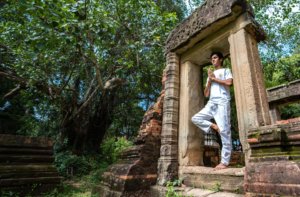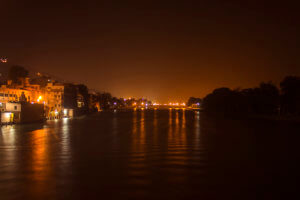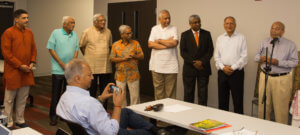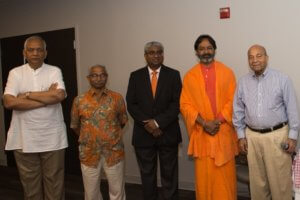Published by Staff Writer, HUA on Feb 5, 2024 12:00:00 AM

The Hindu University of America commemorates the epoch-making punar-uddharana ceremony of the Ram Lala Mandir at Ayodhya with the release of a music video ‘Ayodhya – A Cultural Renaissance’ as a special tribute to the occasion.
Ayodhya – Music Video
This music video is composed and produced by Dr Kanniks Kannikeswaran, a faculty at HUA. The video weaves a 21st century multimedia-digital portrait of Ram using elements of Indian Classical music, Sanskrit Lyrics and powerful imagery. Earlier in 2022, Dr Kanniks had created the highly acclaimed work ‘Raag Darshan’ a portrait of India in 75 Ragas.
‘Ayodhya’ is released on the HUA Youtube Channel and will mark the occasion in a musical medium that integrates classicism, story telling, history, philosophy, Sanskrit, Hindustani and Karnatic music.
Celebrating the consecration of the mammoth Ram temple in Ayodhya and the cultural renaissance of Ayodhya through this musical medium is more than a fitting way to celebrate the epochal event. In creating this digital monument, we follow the model of leaders such as Rajendra Chola who built monuments such as the Gangai-konda-Cholapuram temple and engraved historic records in the form of inscriptions (celebrating the pan Indian outlook of the Cholas in their victorious march to the basin of the river Ganga), the footsteps of the Nayanmars, Alvars, and the Vaggeyakara Muthuswami Dikshitar.
Conceptualization, Research, Lyrics, Music, Script, Direction: Dr Kanniks Kannikeswaran
Running length: 7.5 min
Release Date: January 21 11:00 am CST, in time for the consecration of the temple at Ayodhya
Lyrics:
śrī rāmachandram sadārādhayeham
śrīmadayodhyā sadanam dinamaṇi ravikula tilakam
nīrāgam nirāmayam nijānanda sukhapradam
nirālambam nirmalam- virājita sarayū taṭam
krūratara pāpa rahitam – māruti suhrdaya viditam
tāraka nāma sucharitam – dharma sthāpakam aniśam
ayodhyāpura- janmakshetram ānjaneya sannutam –
kalyāṇyā,,ramayā saha- kanaka bhavana- nivasitam|
koṭi-koṭi dīpavijita chandravadana— sphuritam
lalāṭa-tilaka-śobhita- traya- anuja-sahita-janitam
yogījana- kinkara- sevaka – suranarendra moditam –
yugāntara prasiddham -ati- nūtana mandıra- lasitam
parāśarātmajāśritam -mahāmatyādi vanditam
apāra- karuṇā pāngam -hridayasthitha māmakam –
śrī tyāgarāja-chakravarti-kamba – rāmadāsa
gosvāmi tuḷasIdāsa- kavikulaguru kāḷidāsa
bodhāyana- muni vasiṣṭha – śrī guruguha- mahā śreṣṭha
kulaśekhara – kavikokila śrīmadvālmikyārcita
martyāvatāra – maryādā puruṣottama
śrī rāma rāma rāma śrī rāma rāma rāma
raghupati rāghava rājā rāma
jai-śrī rāma rāma
śrī rāmachandram sadārādhayeham
Translation:
I always celebrate Sri Ramachandra who is enshrined in Ayodhya and who is the crown jewel of the Solar Lineage.
Who is beyond likes and dislikes, who confers true joy, who is pure and free and is enshrined on the banks of the river Sarayu. He destroys the accumulated karma and is ever present in the heart of Hanuman. His name bestows liberation and he is worshiped as the one who established the order of dharma in the form of Ramarajya.
He is enshrined in his birthplace in Ayodhya ; Anjaneya resides in his presence (at Hanuman Garhi). He is seated with Sita (who is endowed with auspiciousness Kalyan) by his side in Kanak Bhavan. His moon-like face excels the Dipotsav in its brilliance; born with three brothers, the tilak on his forehead radiates with effulgence. He is revered by the renunciates, the devotees engaged in service, humans, kings and the Gods; his presence in Ayodhya has been well known for eons; and he is (now) worshiped in a newly constructed temple. He is worshiped by great intellectuals such as Vyasamuni (the son of Parashara); he is filled with kindness and compassion beyond compare and he resides forever in my heart.
Victory to Rama, who is worshiped by Swami Tyagaraja, Kavi Chakravarti Kamban, Bhadrachala Ramadasa, Goswami Tulasidasa, Mahakavi Kalidasa, Bodhayana, Vasishta, Muthuswami Dikshitar, Kulasekhara Alwar, Maharishi Valmiki; an avatar in the human form, who is hailed as the noblest of purushas. Jai Shri Ram.
Thoughts from the Composer
Why it occurred to me to create this music video: A significant part of my understanding of Hindu Dharma is through temple visits and the Tamil liturgical music of the 700s and the Sanskrit Kritis of Muthuswami Dikshitar (1775-1835). The 1st millennium Tevaram songs are in praise of temples all over Tamilnadu and they provide a historical record of the temples in existence about 1300 years ago. The music of Dikshitar is along similar contours, and it uses the pan-Indian medium of the Sanskrit language and the Ragas of the 1700s and 1800s.
Much of the music that I have created over the years celebrates Bharat and the Dharmic Civilization. (e.g. Rivers of India, Monsoons (using the Tirukkural), Raag Darshan – A tribute to Bharat in 75 Ragas). During my recent trip to Bali, where I was blown away by the significant presence of Hindu dharmic ideas – I mused on how Dikshitar would have created music, had he visited Bali. The result was a music video ‘Om Swastiastu’, which uses the medium of the Kriti in Sanskrit, with visuals from all over Bali.
It was around Navaraatri 2023 that I figured out that time was running out*, and a similar kriti /video needed to be created in time for Jan 22. A kriti, which would narrate the story of Ram in Ayodhya, the geography of Ayodhya, the history, and the worship traditions with powerful visuals to accentuate the story. I wrote the first draft of the kriti during Navaratri; made a rough recording after Deepavali. Visited Ayodhya in early December; made a few changes based on the experiential understanding of Ayodhya; recorded the vocals over the Christmas holiday break, and worked on finishing and post-production all the way until Jan 22.

Moola Vigraha at the Ram Janmabhoomi Mandir
What Ram means to me: Raman is as much a Tamil word as it is a Sanskrit word. Rama-Nama-Japam is very common; and writing ’Sri Rama Jayam’ down multiple times is a powerful exercise that is steeped in Bhakti, stills the mind and improves focus. I have seen people do it all the time. Ram gets referred to in Tamil film songs very often. There is no family with a relative not named after Ram. Even Ayodhya is part of the Tamil vocabulary. Dikshitar refers to Ayodhya as ‘Saketa Nagar’. In the course of my working on music with various groups, the most moving stories regarding the relationship to ‘Ram’ are those thatI have heard from the Indo-Caribbean diaspora.

Ayodhya Ram Janmabhoomi Teertha Kshetra Mandir
What Ayodhya meant to me: My visit to Ayodhya in December this year was a memorable one where circumstances conspired to make it happen. It is a place that has its ‘vibes’. ‘Ram’ is in the air, water and soil and in peoples heart and lips in Ayodhya. There is a simplicity of life that reminded me of Bali. The narrow lanes, surprises around every corner, small temples, the sound of bells, the sound of Ram-Dhun wafting in the air from all directions; the simple greeting ‘Jai Shri Ram’, the kirtankars doing nothing but singing kirtans all day long, the various landmark temples, the lofty towers, the chill breeze by the Sarayu, the modern Arti on the river – all these are memories to cherish; in a lot of ways it was a transformative visit; one that enabled to me to experience the feeling of ‘surrender’ or ‘sharanagati’.

Prana Pratishtha at Ayodhya
What the prana-pratishtha means to me:
It is a ‘punar-uddharana’ or a renaissance of the entire landscape of Ayodhya. It is a renewal. It is a moment of civilizational awakening. The town, the state, the nation (and even the diaspora) will never be the same again. There is a tremendous sense of confidence, an upsurge of energy; the enthusiasm to serve. There is a major renaissance of the ecosystem around Ayodhya. Who would have imagined 10 years ago that Ayodhya would be home to an International Airport with flights (potentially) to Thailand and other places in the Dwipantara (Far East) with deep-rooted connections to Indian culture and dharma? From having been a sleepy town to one which was internationally known for a ‘dispute’ is now a flourishing center of religious tourism. It is only a matter of time before Universities get set up here. To me, this revival and renewal is a moment of tremendous possibility and inspiration; that shows the power of sankalpa or intentionality.
What did I want to convey using the lyrics: I wanted to paint a picture of Ayodhya as it is today. The raga chosen is ‘Kalyan’- in acknowledgement of the auspicious ‘Kalyana-gunas’ of Shri Ram. The first part of the composition describes the timeless attributes of Ayodhya-Ram, the scion of the Surya Vamsha. Ram as the Brahman – the truth of existence, who in his Saguna form resides on the banks of the Sarayu and is ever present in the heart of Maruti. The next part of the composition describes the various landmarks in Ayodhya (Hanuman Garhi, Kanak Bhavan, Sarayu, Rama Janma Bhumi mandir) and the attributes of the vigraha. There is a line in there that describes the effulgence of his Tilak (that I had written even before becoming aware that the temple was designed to have the sun illuminate his tilak once a year). There is another that compares the moon-like face to the brightness of the Dipotsav.
The kriti also acknowledges the love that the devotees express towards Ram; and puns on words to acknowledge the 21st century contributors to the temple. (For instance, the phrase ‘sura-nara-indra-moditam’ has the word Narendra-Modi hidden in it; ‘Parasharatmaja’ acknowledges Shri Parasharan and the word ‘mahamatyadi’ acknowledges the archeologist K. K. Mohammed). It concludes that (apart from the places described above) Ram resides in our heart.
Purvikas: The next part of the composition acknowledges several poets and musicians who have sung of Rama. Tyagaraja and Muthuswami Dikshitar (both of whom were mentored by Upanishad Brahmam an exemplary Ram Bhakta in Kanchipuram), Kalidasa, Bhadrachala Ramadasa, Kalidasa and others, and of course Valmiki.
Mudras: I acknowledge Dikshitar as the source of my inspiration using the phrase ‘Sri guruguha Maha sreshta’ and use my mudra- ‘Vidita’ in the phrase ‘Maruti Su-hrdaya viditam’.
The final part of the composition is a kirtan which is pictured on the Arti in Sarayu.
Artists: The singers Abhay Jodhpurkar and Reeshabh Purohit have done a fantastic job emoting the song and delivering it with spirit. The tabla accompaniment by Sai Shravanam is stupendous (and so is the soundscape that he has captured); the sarod played by Pratik Shrivastav adds a layer of depth; the choral singers provide ample support. I have sung a few lines along in the final recording as well.
It was a moving experience to be struck with revelations and discoveries as I composed and produced this piece; it was even more moving to watch the finished product and see the story come alive with great camera work on the artists and other visuals, edited elegantly by Sachin Dave.
My Sankalpa: It is my wish to share this with the world at large and inspire everyone to make a trip to Ayodhya in their lifetime. It is also my Sankalpa to make such music videos on 6 other places Kashi, Kanchi, Mathura, Ujjain, Haridwar and Puri – which along with Ayodhya constitute the 7 moksha-puris. (That I had referred to in the 75 Ragamala, in the raga Purya).
My Sankalpa: It is my wish to share this with the world at large and inspire everyone to make a trip to Ayodhya in their lifetime. It is also my Sankalpa to make such music videos on 6 other places Kashi, Kanchi, Mathura, Ujjain, Haridwar and Puri – which along with Ayodhya constitute the 7 moksha-puris. (That I had referred to in the 75 Ragamala, in the raga Purya).
*My initial idea was to produce a documentary film on the Footprints of Rama tracing his journey (Ramayana) through India using music and visuals from various parts of India. I had even written the outline of a script and a proposal. Perhaps it will happen at a later date.
About the Composer: Dr. Kanniks Kannikeswaran is an internationally renowned music composer, educator and scholar and an award winning filmmaker who is known for his sustained contribution to music and community for the past 25 years. His recent viral video, Rivers of India has received critical acclaim and has gone viral with words of praise from such luminaries as Anand Mahindra. Kanniks is regarded as a pioneer of Indian American Choral music; his far-reaching work in this area has touched the lives of over 3500 performers, inspired the flowering of community choirs in more than 12 U.S. cities, and built new audiences and collaborations. His flagship production ‘Shanti A Journey of Peace’ featuring a cast of 200+ is rooted in the Upanishadic vision of oneness and portrays 5000 years of Indian cultural history using choral music and multimedia.

Dr. Kanniks At Ayodhya
His research and his first-ever recording of the Indo Colonial Music of eighteenth-century composer Muthuswami Dikshitar in 2008 and his Documentary film ‘Colonial Interlude’ have received critical acclaim and awards in film festivals. Kanniks has collaborated with well-known ensembles and musician such as as Bombay Jayashri, Kaushiki Chakraborty, Ajay Chakraborty, Ranjani and Gayatri, Lakshmi Shankar, the Cincinnati Chamber Orchestra, the Cincinnati Pops Orchestra and others. Kanniks is the recipient of several awards including the Ohio Heritage Fellowship and the Distinguished Alumnus Award from IIT Madras.










